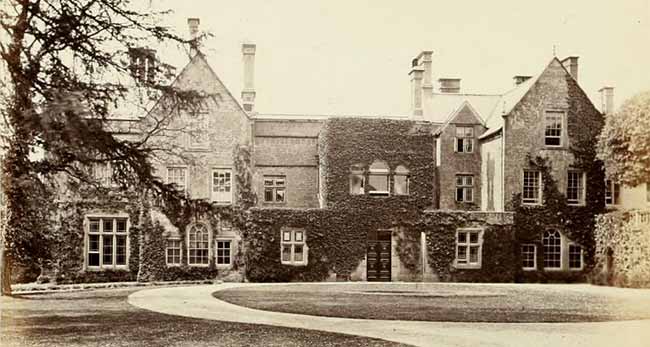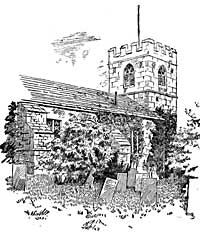Annesley
Annesley Associated With Many Notable Families
The Manners Connection

The east front of Annesley Hall, c.1874.
AT some time during the Anglo-Saxon era a man named Ane came into this district, maybe by way of the Leen, prospecting for a home. He would see the hills bleak and barren, earthworks ancient even then, perhaps a track of the Ryknield Way, the streamlet flowing to the Leen, with its promise of fish, bubbling wells offering a pure water supply, and fertile soil which had been deposited when the ice of the Glacial Period broke up. Here, according, he stayed; he hewed down part of the woods, and made a dwelling, and protected it by a stockade of timber, and as Annesley (the clearing of Ane) the place has ever since been known.
His name was not uncommon ; there was an Ane who was king of the East Anglians in the middle of the 7th century, and though there was probably no relationship between the two men, they may have been contemporaries.
The last of the Saxon owners was Levenot, whose possessions here and at Kirkby, Cossall, and Bunny were granted by William I to one of his followers, Ralph Fitz-Hubert, who instituted one Richard as his tenant. Richard is presumed to have been ancestor of the Britos who subsequently called themselves Annesleys, and so long as they rendered their feudal dues to their overlord they were practically owners of the manor and lordship. It may be inferred that he built himself a hall and possibly a church; the tub-font in the now deserted old church beside the Hall is a fine example of Norman handiwork.
The Fitz-Hubert interest seems to have ended by 1154, when Robert of that family was besieged and captured in Devizes Castle and hung on its battlements like a common thief, for his cruelties whilst fighting for Stephen, and the Stutevilles had grant of fifteen of his knight’s fees, while some of the old Levenot lands passed to the Frechevilles. Two years later, in 1158, when Ralph Brito, Lord of Annesley, founded Felley Priory, Leonie de Raine and her son Henry de Stuteville bestowed upon it the church of Annesley and its appurtenances. The gift was challenged by Brito and Hugh the parson, but at the intercession of the Archbishop of York the differences were composed and all parties agreed to the benefaction.'
Wrested The Magna Charta
Ralph de Annesley was among the barons who wrested Magna Charter from King John—a deed which caused his estates to be escheated, but when John died, in 1218, Ralph quickly made his peace with the new king and recovered them. On the other hand, the notorious Philp Marc, one of John’s trusted friends and abettors, to whom Ralph’s land had been entrusted, rebelled against Henry III, but he, too made concord, and appears to have died shortly afterwards. But Annesley had not done with the Marcs. His successor, Reginald, was reported in 1220 to have built here a castle strong enough to overawe the neighbourhood, and a commission appointed by the king found the allegation to be proved. What happened is not recorded, but the stronghold was probably dismantled, for nothing of its history is known. Hitherto, Annesley had lain just outside the metes of Sherwood Forest, but in 1242 a new perambulation included a portion of it within its bounds and the new limit hereabouts passed along "the great road, below the old castle." Castle Wood, on high ground overlooking the road to Linby, half a mile south-east of the Hall, marks its site and a low grass-covered bank there may cover the remains of a wall.
In 1280, by charter granted at Newstead, Edward I gave the Annesleys the right of free warren on their lands, and in 1327 John de Annesley was empowered to clear 60 acres of his wood here and enclose it within a ditch and hedge, but the dyke was not to be so broad nor the hedge so high as to impede the royal deer. Later in the reign of Edward III, as the result of the piety of Wm. de Wakebrugge —a notable Church benefactor—and Robt. de Annesley, parson of Ruddington, the south or Felley aisle was added to the church. They founded a chantry in it, and endowed it with properties in 1363.
Crop of Lawsuits
In 1439 Alice, daughter and heir of John de Annesley, had married George Chaworth, to whom she brought Annesley and her other inheritances, and henceforward, until "Byron’s Mary" carried in it marriage to John Musters, the greater part of the village and its territory remained with the Chaworths. Her husband was of the Wiverton family, but was himself of Cropwell Butler and when he died she married again, retaining the usual third part as her dower, but, it reverted upon her decease to Thomas, her son by her first husband. The Leighs settled at
Annesley, and a generation later Reginald Leigh, of Annesley, gentleman, was accorded a general pardon for unspecified offences. With the advent of the Tudors came the usual crop of lawsuits, John Bassingbourne suing Rd. Illingworth, John Savage suing the prior of Newstead, others claiming Annesley properties, or deeds relating to them. This litigation continued into the reign of Elizabeth, but the details need not here be recited.
Startling Changes
When George Chaworth, Esq., died in 1521, he bequeathed to his son John thirteen messuages, 100a. of arable land, 100a. of meadow, 100a. of heath, and 6s. rent in this manor, and this heir was destined to witness startling changes, for the dissolution of the monasteries was at hand. Felley Priory had been receiving a yearly income of £6 13s. 4d., from its secular possessions in Annesley and £5 6s. 8d. from its church, and it also had land here reserved for the use of its monastic household. The rectory was leased to Rd. Samon and on 30 Sept. 1538, the priory and its other possessions were purchased by Wm. Bolles. These latter included closes here and at Felley called Ollerschay and Corn Bradley, late in the tenure of Wm. Herrott; a messuage and a granary occupied by Thomas Foxe and Jas. Burgys; a close called Okemedowe land another called Lambarstorth; a tenement and three closes in Chepyn Hills in this parish, late held by Elias Rod, and a moiety of the pasture called “le Fulwood” and a meadow known as Birde Medowe, then farmed by Thos. Bykerstaff and Robt. Key. Their annual value was £13 and the rentals amounted to 26s. a year. The grant, in fee simple, included all the houses, orchards, gardens, lands which the priory had owned in Annesley and Felley, with 40a. of meadow, 245a. of pasture, a barn and a water-mill, with other appurtenances, and as Bolles was in the Crown’s Augmentation Office, which was concerned with the surrenders, it may be accepted that the £262 10s. which he paid for his bargain was not too dear.
Church Stripped

Annesley church, c.1905.
Annesley Church had been served by cantarists or canons from Felley, but the dissolution of the priory so seriously curtailed religious ministrations that in 1548 it was reported that there were above 260 parishioners, and that “the parish, being very large and wyde, and of greate distaunce betwene the standing of the houses. They have no more munysters to helpe the Curate but thie Chauntrey preists.” A year or two later the chantries were suppressed, and in 1559 it was stated that there was no curate, the vicarage was not worth more than five marks a year, “and yet there are in number eight score people.” Meanwhile the Great Pillage had taken place, and the church had been denuded of all its ornaments and treasures. All that was left in 1552 was a chalice and paten, two vestments and a cope, an alb and a surplice, a cloth for the Communion-table, and three bells in the tower.
Edward VI founded the Free Grammar School at E. Retford in 1551, endowing it with possessions of the dissolved chantries here and at Sutton-cum-Lound and Tuxford. The funds became misapplied by the school trustees, and it was left for a 19th century inquiry to rescue and restore to their proper use so much of the perverted funds as could be recovered.
Elizabethan "Merrie England” found Annesley in tune with the time, for in 1572 the players of “Ansley and Cropwell” were rewarded with 8d. for entertaining the mayor and his friends at Nottingham. It may be doubted whether this munificence satisfied the recipients, especially as the Queen’s Players almost at the same time received a guerdon off 20s., but it was better fortune than befel another Annesley troupe which in 1624 was paid 4d. not to perform in the fastidious borough. Seven years later the villagers would be awestruck by a visit in state of the mayor and his “brethren” of the Council. There was a wedding at the Hall and the 5s. bestowed upon the butler must have made the local actors envious.
Long Connection
It was in this reign that the Manners family began a long association with Annesley. In 1575 Roger Manners (whose brother John wedded Dorothy Vernon of Haddon) acquired the advowson of the rectory, and soon after the death of Queen Elizabeth the Earl and Countess of Rutland were occupying the Hall either as hosts or guests. Its grounds were at that time being laid out afresh and the Belvoir accounts for 1609 disclose payments amounting to upwards of £100 upon that work. Next year the earl's fishponds here were receiving attention; the countess had medicinal water brought from Belvoir, the house fitments were improved; fish and game were sent here for his lordship’s table; noble guests were entertained, and sums were spent upon musical entertainments during the Christmas of 1612, while in the spring of 1611 the gardens had been brightened as the result of the purchase of “severall sortes of gardaine seedes.” A drawback is implied by the entry that the services of a ratcatcher were retained at Belvoir and Annesley at a cost of 40s. a year.
